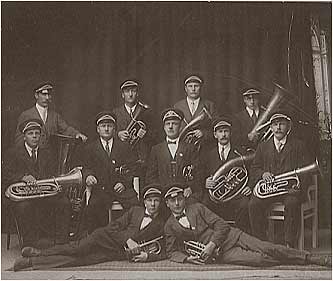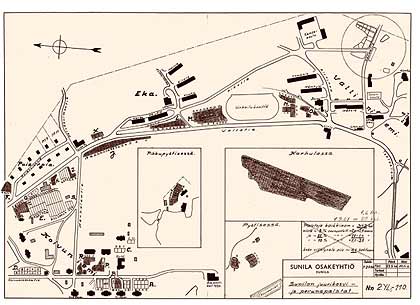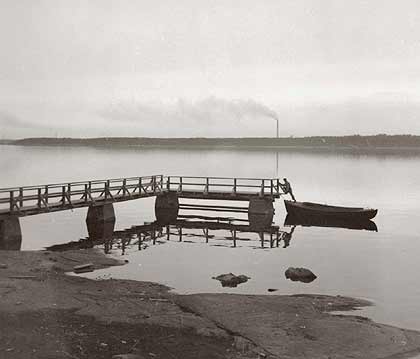THE GOLDEN ERA OF THE COMMUNITY

Photo: Sunila Oy
When the planning and building of the Sunila factory and the housing area linked with it began in 1936 it meant the birth of a whole community and a renewal of life in the area. Situated on an islet, Sunila was a separate area in itself and there was no attempt to link it to the rest of the municipality. This physical separation strengthened the patriarchal spirit endemic to the saw mill trade, which was reinforced in turn by the character of the managing director of the new factory, Lauri Kanto.
|
SERVICES, EDUCATION, LEISURE-TIME ACTIVITIES

Photo: Sunila Oy
Sunila was an active and self-reliant but closed and cliquish community, which offered work, services and leisure-time activities. Some of the large timber buildings in the old Sunila sawmill community were modernised for the use of the new community.
The fire brigade building, inaugurated in 1901, was already an established place for meetings and festive occasions. Aalto designed the renewal and extension in accordance with the custom of the time, without trying to achieve a solution imitating the old. Pirtti, the Sunila community hall, was thus established, a place where the hobby and sports activities of Sunila were centred - truly a multipurpose building.
Health care and medical services as well as children's day care was organised by the company. Day care was begun at the Pirtti community hall, but in 1949 it was able to move its operations into purpose-built facilities in the renewed offices of the former saw mill.
Library facilities have been housed in the renovated former foremen's building of the Sunila sawmill.
The small bathroom facilities in the workers' housing were complemented by the Valliniemi sauna that serviced the whole area.
There were two laundries, including rooms for mangling. The Valliniemi laundry was extended in 1953 and the first electric washing machines were installed.
A trade school, situated in the former primary school building of the old Sunila sawmill community, prepared workers for the needs of local industry. Teaching was given in the departments of metalwork, woodwork, wood industry and glass industry.
Vilho Rikka designed the primary school already in 1939, but the war and financing problems delayed the work and it wasn't completed until 1950.
The founding of a secondary school in Sunila came about through the parents' own activities. The school, designed by Osmo Sipari, opened in 1961 and the first generation of pupils completed their schooling in 1970.
The number of commercial services was incomprehensibly large compared to the general level of the present day services in Sunila
The post office operated in a purpose-built building situated next door to the Valliniemi sauna, there were several banks and grocers and specialty shops such as a pharmacists, a bookstore and a shoe shop.
There was a café-restaurant on the first floor of the trade union shop.
The bus station designed by Alvar Aalto housed a kiosk that operated in the summer, as well as staff facilities for the bus drivers and the conductors; the passengers waited outside on benches. When the sea was free from ice, a regular motor boat service was in operation transporting people in the Kotka direction. Otherwise, bicycles and kick sledges were used as transport. Motor traffic took over gradually from around the mid-1950s.
In 1937 Alvar Aalto designed the conversion of the former sawmill deputy manager's house into an officials' club, with Aino Aalto designing the interior.
The foremen's club was housed in the former saw adjuster's building.
The Toukola club house was completed in 1953 in Popinniemi near the Sunila housing area. The variety of activities taking place there was wide: a day care, youth clubs, study circles, a Sunday school and pensioners' meetings.
The company repaired a crafts workshop in Väinölä, an old timber building left standing on the factory island, for "joiners and handymen". There was also a separate building reserved for boat making.
A fire brigade was of course a necessity among the facilities in every saw mill, but in Sunila it was much more than its name implied. Most officials and even engineers in the technical department belonged to it.
The fire brigade practices that took place every Monday were undoubtedly visible in the life of the community. Fireman skills were practiced, maintenance work was carried out and finally they played some sports together. The fire brigade was also responsible for the ambulance service.
|
A SELF-RELIANT COMMUNITY

Photo: Sunila Oy
"We were in the middle of war time and bad shortages. The worst winter for food was the winter of 1942. Hoarding trips were made in the vicinity and further away by bicycle. Allotment gardening was also begun, and there were allotments for instance along Sunilantie road, in the yards of the houses and elsewhere. Domestic animals were kept where possible. Pigs were everywhere, for instance on the EKA hill. We had a goat, which ate all the food scraps and whatever we could get hold of…" (Matti Kanto, the son of executive director Lauri Kanto)
Self-reliance was a natural aspect of life in Finland up until the beginning of the process of urbanisation, that is, the 1950-60s. Especially the shortages following the 1939-45 wars forced people to be active and inventive.
The residents of Sunila had over 400 potato and root-vegetable plots immediately after the war in the Sunila area. The home-economics expert hired by the company helped and held courses in matters related to cultivation and clothes maintenance. When there was a shortage of everything, recycling came about naturally; for instance, the old felt from the drying machine was found to be a good and durable material for clothes and carpets. When the Martta organisation (a nationwide organisation founded in order to promote good housekeeping) began in 1942 home economics information was efficiently spread throughout the country.
The Sunila company transported the workforce and their families with its bus to gather forest berries and mushrooms, and the Sunilan Viesti kindled its competitive spirit. In the summer of 1943 there were 35 berry-picking trips and about 1700 people participated, picking about 23,000 litres of berries. The inhabitants of Sunila also distinguished themselves in the national firewood campaign, which aimed at preventing a fuel shortage.
|
CHANGE, VARIETY AND RECREATION

Photo: Sunila Oy
To get out into freedom, to the sea, to the fresh air, were surely thoughts in the minds of many inhabitants in Sunila as spring came. The dwellings were after all constricted in relation to family size and the smoke coming from the factory flues was not as clean as it is today.
The company acquired in 1946 a shoreline plot where it founded a summer holiday resort for its employees. Nature, however, was the most important aspect. People spent the night in tents and cabins. The journey was made with the factory's regular service boat (though some had their own boat) with picnic lunches, cooking utensils and other camping gear along.
People swam, used the saunas, fished, played games and sports, danced on the open-air dance floors, and generally enjoyed summer. Sailing courses were arranged with two sailing boats called Sipi and Sotka, made available to all staff, and mid-summer feasts with bonfires and other traditions were arranged.
|
SPORT

Photo: Sunilan Sisu Ry
Sport took place in Sunila both in the competitive sense as well as for recreation. The most popular sports were (in winter) skiing, and amongst young people also skating, ice-bandy and even ice-hockey. Skiing competitions with their many different classes, were the highlight of the winter and people actively took part in them; the usual number of participants for the Sunila winter sports event rose to over 300. In summer athletics, football and baseball were the most popular sports. Each summer in the "Sunila Olympics" there were some events, such as triathlon and middle-distance running, that attracted a couple of hundred participants. Orienteering became extremely popular and there was success in this sport even outside the Sunila area.
At its peak, the Pirtti community hall was in almost continuous use for different sports. There were practice times for women's, men's, girls' and boys' gymnastics groups, wrestling, weightlifting and boxing every week-day night.
The Sunila Sisu sports club was founded in 1937. Already the following year it was chosen to arrange the Finnish championships in apparatus gymnastics. After successfully hosting the event, the Sunila company hired the gymnastics instructor Esa Seeste, who had been successful in the championships, as a full-time sports instructor in Sunila. Sunila Sisu won the Finnish team championship in the discipline three times, in 1939, 1941 and 1945.
|
ROWING
Rowing became an even more prestigious sport than gymnastics in Sunila. Sunila Soutajat [Sunila Rowers] was founded in 1945 and it had already from the very beginning a special position under the patronage of the company director. The rowing team in Sunila rose to achieve great success unbelievably quickly. The cox-less four won the Finnish championships eight years in a row.
The Sunila team represented Finland in the Olympic Games in London in 1948 and came sixth. In 1951 the German coach Kurt Hoffman was hired by the Finnish Rowing Association and visited Sunila, and soon a real test lay ahead, the Olympic Games held in Helsinki the following year. In the finals, Finland and Sunila took the bronze medal. The medal-winning team consisted of Veikko Lommi, Kauko Wahlsten, Oiva Lommi and Lauri Nevalainen.
The success of the Sunila rowing team continued for some years, for instance in Nordic competitions, but they were never chosen to represent Finland in any further Olympic Games. Rowing continues today as a sport in Sunila, but as a leisure sport and with competitions between different companies.
|
» PDF (5,3Mb)
- Sirkka Soukka
|
|

|
|
